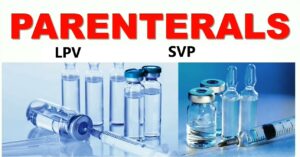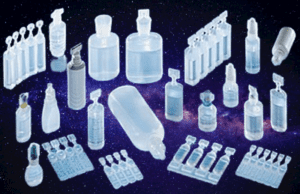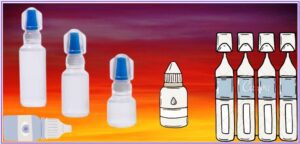The world of parenterals, where drug administration transcends the confines of the intestine. Discover sterile parenteral products, including drugs, solutions, emulsions, and suspensions, designed for administration through non-oral routes. Uncover the unique characteristics, benefits, and advancements in parenteral drug delivery, shaping the landscape of modern pharmaceuticals.
Parenterals, a term derived from the Greek words “para” meaning “outside” and “enteron” meaning “the intestine,” have revolutionized drug administration practices. This classification refers to the administration of drugs through any route other than the intestinal tract.
Parenteral products encompass a wide range of sterile formulations, including drugs, solutions, emulsions, and suspensions. These specialized preparations are carefully designed for administration via non-oral routes, such as intravenous (IV), intramuscular (IM), subcutaneous (SC), or intradermal (ID) routes. By bypassing the intestine, parenterals offer direct and efficient delivery of medications to targeted sites in the body, ensuring rapid onset of action and precise dosage.
Parenteral definition
Parenteral preparations are sterile preparations comprising one or more active substances that are intended for administration into the body via injection, infusion, or implantation. They are available in single-dose or multi-dose vials.
what are parenterals
One crucial aspect of parenteral products is their sterility. Rigorous manufacturing processes are employed to eliminate microorganisms, reducing the risk of infections during administration. This sterile nature of parenteral products is particularly significant when oral administration is impractical, ineffective, or undesirable.
Parenterals have transformed the field of drug delivery, offering numerous benefits and advancements. By providing alternative routes of administration, parenterals expand the therapeutic possibilities for various medical conditions. They enable the delivery of medications that require rapid action, precise dosing, or cannot be effectively absorbed through the digestive tract.
Moreover, parenterals open doors to specialized treatments, such as intravenous infusions, targeted injections, or implantable devices. Intravenous parenteral solutions play a vital role in fluid replacement, electrolyte balance, and the administration of life-saving medications. Intramuscular and subcutaneous injections offer convenient and localized drug delivery, while intradermal injections are crucial for allergy testing and specific diagnostic procedures.
Types of parenterals
| Type | Route of Administration | Examples |
|---|---|---|
| Intravenous (IV) | Administration into veins | IV fluids, electrolytes, medications |
| Intramuscular (IM) | Administration into muscle | Vaccines, antibiotics, hormonal medications |
| Subcutaneous (SC) | Administration beneath skin | Insulin, growth hormones, anticoagulants. |
| Intradermal (ID) | Administration into dermis | TB skin tests, allergy testing. |
| Intrathecal/Epidural | Administration into spine | Pain medications, anesthetics. |
| Intra-articular | Administration into joints | Corticosteroids, viscosupplements. |
| Intraocular | Administration into eye | Medications for intraocular diseases. |
| Inhalation Solutions | Administration via inhalation | Bronchodilators, and nebulized medications. |
| Intravenous Infusions | Continuous or intermittent IV | Chemotherapy, antibiotics, pain management. |
| Total Parenteral Nutrition (TPN) | Intravenous nutrition | The complete nutrient solution for patients unable to obtain nutrition orally or enterally. |
Types of parenterals in terms of volumes.
| Type | Capacity |
|---|---|
| Small Volume Parenterals (SVP) | Typically less than 100 mL |
| Large Volume Parenterals (LVP) | Typically 100 mL or more |
| Extra-Large Volume Parenterals (ELVP) | Typically 1 liter (1000 mL) or more |
Tests of the parenterals
- Sterility

- Free from Pyrogen
- Free from particulate matter
- Clarity
- Stability
- Isotonicity
Advantages of parenterals
- Rapid Onset of Action: Parenterals offer a direct route of drug administration, bypassing the digestive system. This allows for quicker absorption and onset of action compared to oral medications.
- Precise Dosage: Parenterals allow for precise dosing, as the exact amount of medication can be administered based on the prescribed dosage.
- Optimal Drug Delivery: By delivering medications directly into the bloodstream or target tissues, parenterals ensure efficient drug delivery to the desired site of action, maximizing therapeutic benefits.
- Higher Bioavailability: Parenterals can achieve higher bioavailability as they bypass the first-pass metabolism in the liver, resulting in a greater proportion of the administered dose reaching the systemic circulation.
- Suitable for Non-Compliant Patients: Parenterals are ideal for patients who are unable to take medications orally or have difficulty with medication adherence, ensuring consistent delivery of the prescribed therapy.
- Emergency Situations: In critical or emergency situations where immediate action is required,
 parenterals allow for the rapid administration of life-saving medications.
parenterals allow for the rapid administration of life-saving medications. - Accurate Titration: Parenterals offer the ability to titrate medication doses precisely, allowing healthcare professionals to adjust dosage levels as needed for optimal patient response.
- Enhanced Drug Stability: Parenteral formulations can provide increased stability for certain drugs, protecting them from degradation and improving their shelf life.
- Reduced Gastrointestinal Side Effects: By bypassing the gastrointestinal tract, parenterals can help reduce or eliminate potential adverse effects associated with oral medications, such as nausea, vomiting, or gastrointestinal irritation.
- Flexibility in Route of Administration: Parenterals offer multiple routes of administration, including intravenous, intramuscular, subcutaneous, and intradermal, allowing healthcare professionals to choose the most suitable route based on the medication, patient condition, and desired therapeutic effect.
Formulation of parenterals
1. Therapeutic agents
- Vehicles
- Water.
- Water miscible vehicles.
- Non-aqueous vehicles.
- Added substances (Additives).
- Preservatives.
- Solubilizing agents.
- Tonicity-adjusting agents.

- pH adjusting agent.
- Antimicrobials.
- Antioxidants.
- Chelating agents.
Disadvantages of Parenterals:
- Invasive Administration: Parenterals require the use of needles or catheters for administration, which can be uncomfortable, cause pain, and carry a risk of local tissue damage or infection at the injection site.
- Professional Administration: Most parenteral medications need to be administered by trained healthcare professionals, limiting their use to clinical settings and making self-administration difficult for patients.
- Risk of Infection: Despite sterile preparation, parenteral administration carries a risk of introducing infection. Strict aseptic techniques must be followed during preparation and administration to minimize this risk.
- Potential for Medication Errors: Parenterals require careful handling and precise dosing, making them susceptible to medication errors if not properly prepared, labeled, or administered.
- Limited Drug Formulations: Certain drugs may not be suitable for parenteral administration due to their physical or chemical properties, limiting the range of available parenteral formulations for specific medications.
- Higher Cost: Parenteral formulations and administration equipment can be more expensive compared to oral medications. This increased cost may be a limiting factor, especially in resource-limited healthcare settings.
- Need for Specialized Storage and Handling: Some parenteral medications require specific storage conditions, such as refrigeration or protection from light, which may add complexity to their storage and handling requirements.
- Potential for Adverse Reactions: Parenteral medications can carry a risk of adverse reactions, including allergic reactions, anaphylaxis, or local tissue irritation, which require close monitoring and immediate medical intervention if they occur.
- Limited Self-Administration: Parenteral medications often require professional administration, limiting the independence and convenience of patients who may prefer self-administration.
- Lack of Flexibility in Dosage Adjustments: Once a parenteral medication is administered, it is challenging to adjust or reverse the effects of the medication, especially with long-acting formulations. This limitation can be problematic if the patient’s condition changes or if a dosage adjustment is needed.
Frequently Asked Questions
What is a parenteral?
Answer: A parenteral refers to the administration of drugs or solutions by any route other than the intestine.
What are the different routes of parenteral administration?
Answer: The different routes of parenteral administration include intravenous, intramuscular, subcutaneous, intradermal, intrathecal, epidural, intra-articular, intraocular, and inhalation.
What are the advantages of parenteral administration?
Answer: Some advantages of parenteral administration include rapid onset of action, precise dosage delivery, optimal drug delivery, higher bioavailability, and suitability for non-compliant patients.
What are the challenges associated with parenteral administration?
Answer: Challenges include the invasive nature of administration, the risk of infection, the need for professional administration, potential medication errors, and higher cost compared to oral medications.
How are parenterals prepared in a sterile manner?
Answer: Parenterals are prepared in a sterile manner using aseptic techniques in cleanroom environments, including proper hand hygiene, wearing sterile gloves, using sterile equipment, and maintaining a controlled environment.
What is the purpose of using parenteral packaging materials?
Answer: Parenteral packaging materials are designed to provide a sterile barrier, protect the product from contamination, maintain product stability, and provide ease of administration.
What are the considerations for selecting the appropriate parenteral route of administration?
Answer: Considerations include the drug’s characteristics, desired therapeutic effect, patient condition, the need for rapid onset of action, and the ability of the patient to tolerate the chosen route.
What is the importance of proper labeling and identification of parenteral products?
Answer: Proper labeling and identification ensure accurate administration, minimize the risk of medication errors, provide important information about the product, and support traceability and accountability.
How are parenterals stored to maintain their stability and integrity?
Answer: Parenterals are typically stored in controlled environments, following specific temperature, light, and humidity requirements outlined by the manufacturer to maintain product stability and integrity.
What are the quality control measures for parenteral products?
Answer: Quality control measures include rigorous testing of raw materials, in-process testing during manufacturing, sterility testing, potency testing, stability testing, and compliance with regulatory standards.
What are the considerations for selecting the appropriate parenteral solution for a specific patient?
Answer: Considerations include the patient’s medical condition, fluid and electrolyte balance, nutritional needs, compatibility with other medications, and any specific requirements or restrictions.
How are parenteral medications administered to pediatric patients?
Answer: Parenteral medications for pediatric patients may require adjustment of dosage based on weight, age, and individual patient characteristics. Specialized administration devices and techniques may be used to ensure accurate and safe administration.
What are the precautions for parenteral administration in elderly patients?
Answer: A: Precautions include careful assessment of renal and hepatic function, potential drug interactions, the risk of dehydration, and monitoring for adverse reactions or complications.
What are the common complications associated with parenteral administration?
Answer: A: Common complications include infection at the injection site, extravasation, thrombophlebitis, allergic reactions, anaphylaxis, and local tissue damage.
How are parenteral products disposed of safely?
Answer: Parenteral products should be disposed of according to local regulations and guidelines for hazardous waste disposal to prevent environmental contamination and ensure proper handling of potentially infectious materials.


 parenterals allow for the rapid administration of life-saving medications.
parenterals allow for the rapid administration of life-saving medications.